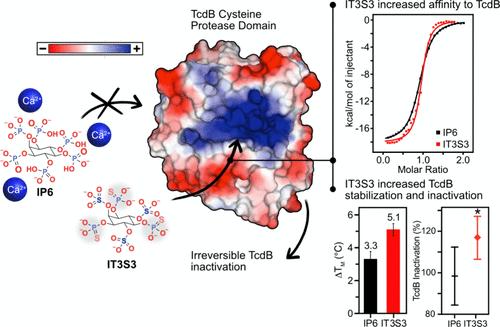作为艰难梭菌毒素 B 异构激活剂的肌醇硫代磷酸类似物的结构-活性关系
IF 6.8
1区 医学
Q1 CHEMISTRY, MEDICINAL
引用次数: 0
摘要
艰难梭菌是一种可导致危及生命的肠道感染的细菌。感染症状是由该细菌分泌的毒素引起的。毒素的致病机理受细胞内分子肌醇六磷酸酯(IP6)的调节。IP6 与毒素上的半胱氨酸蛋白酶结构域(CPD)结合,诱导自蛋白水解,从而释放出细胞胞体中的毒力因子。我们开发了第二代 IP6 类似物,其设计目的是在毒素摄取之前诱导肠腔内的自体蛋白分解,从而规避致病机理。我们合成了一组含硫代磷酸盐/硫酸盐的 IP6 类似物,并鉴定了它们与毒素的结合亲和力、自体蛋白水解诱导作用和阳离子相互作用。与 IP6 不同,我们的首要候选化合物可溶于细胞外的阳离子浓度。IP6 类似物比 IP6 带有更多负电荷,从而提高了亲和力和 CPD 的稳定性,增强了毒素的自身蛋白水解。我们的数据说明了硫代磷酸生物类似物对 IP6 的优化,这种类似物比原生配体更能诱导毒素的自身蛋白水解,值得在体内进一步研究。本文章由计算机程序翻译,如有差异,请以英文原文为准。

Structure–Activity Relationship of Inositol Thiophosphate Analogs as Allosteric Activators of Clostridioides difficile Toxin B
Clostridioides difficile is a bacterium that causes life-threatening intestinal infections. Infection symptoms are mediated by a toxin secreted by the bacterium. Toxin pathogenesis is modulated by the intracellular molecule, inositol-hexakisphosphate (IP6). IP6 binds to a cysteine protease domain (CPD) on the toxin, inducing autoproteolysis, which liberates a virulence factor in the cell cytosol. We developed second-generation IP6 analogs designed to induce autoproteolysis in the gut lumen, prior to toxin uptake, circumventing pathogenesis. We synthesized a panel of thiophosphate-/sulfate-containing IP6 analogs and characterized their toxin binding affinity, autoproteolysis induction, and cation interactions. Our top candidate was soluble in extracellular cation concentrations, unlike IP6. The IP6 analogs were more negatively charged than IP6, which improved affinity and stabilization of the CPD, enhancing toxin autoproteolysis. Our data illustrate the optimization of IP6 with thiophosphate biomimetic which are more capable of inducing toxin autoproteolysis than the native ligand, warranting further studies in vivo.
求助全文
通过发布文献求助,成功后即可免费获取论文全文。
去求助
来源期刊

Journal of Medicinal Chemistry
医学-医药化学
CiteScore
4.00
自引率
11.00%
发文量
804
审稿时长
1.9 months
期刊介绍:
The Journal of Medicinal Chemistry is a prestigious biweekly peer-reviewed publication that focuses on the multifaceted field of medicinal chemistry. Since its inception in 1959 as the Journal of Medicinal and Pharmaceutical Chemistry, it has evolved to become a cornerstone in the dissemination of research findings related to the design, synthesis, and development of therapeutic agents.
The Journal of Medicinal Chemistry is recognized for its significant impact in the scientific community, as evidenced by its 2022 impact factor of 7.3. This metric reflects the journal's influence and the importance of its content in shaping the future of drug discovery and development. The journal serves as a vital resource for chemists, pharmacologists, and other researchers interested in the molecular mechanisms of drug action and the optimization of therapeutic compounds.
 求助内容:
求助内容: 应助结果提醒方式:
应助结果提醒方式:


